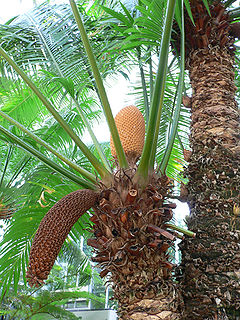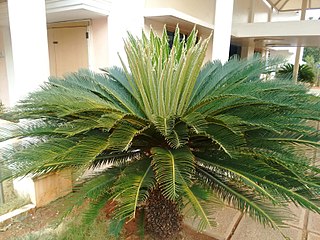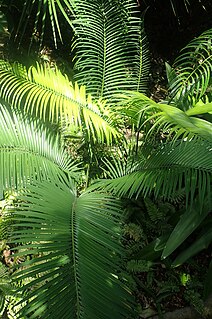
Cycads are seed plants with a very long fossil history that were formerly more abundant and more diverse than they are today. They typically have a stout and woody (ligneous) trunk with a crown of large, hard and stiff, evergreen leaves. They usually have pinnate leaves. The species are dioecious, therefore the individual plants of a species are either male or female. Cycads vary in size from having trunks only a few centimeters to several meters tall. They typically grow very slowly and live very long, with some specimens known to be as much as 1,000 years old. Because of their superficial resemblance, they are sometimes mistaken for palms or ferns, but they are not closely related to either group.

Cycadales is an order of seed plants that includes all the extant cycads. These plants typically have a stout and woody (ligneous) trunk with a crown of large evergreen leaves. They usually have pinnate leaves. The individual plants are either all male or all female (dioecious). Cycads vary in size from having trunks only a few centimeters to several meters tall. They typically grow very slowly and live very long, with some specimens known to be as much as 1,000 years old. Because of the superficial resemblance, they are sometimes confused with and mistaken for palms or ferns, but are only distantly related to either.

Cycas is a genus of plants belonging to a very ancient lineage, the Cycadophyta, which are not closely related to palms, ferns, trees or any other modern group of plants. They are evergreen perennials which achieved their maximum diversity in the Jurassic and Cretaceous periods, when they were distributed almost worldwide. At the end of the Cretaceous, when the non-avian dinosaurs became extinct, so did most of the cycas in the Northern Hemisphere.

Cycas revoluta, is a species of gymnosperm in the family Cycadaceae, native to southern Japan including the Ryukyu Islands. It is one of several species used for the production of sago, as well as an ornamental plant.
Sago palm is a common name for several plants which are used to produce a starchy food known as sago. Sago palms may be "true palms" in the family Arecaceae, or cycads with a palm-like appearance. Sago produced from cycads must be detoxified before consumption. Plants called sago palm include:
Cycas arnhemica is a species of cycad in the genus Cycas, native to Australia, in the northwest of Northern Territory in Arnhem Land, after which it is named.

Cycas balansae is a species of cycad in the genus Cycas, native to southwestern China and adjacent northern Vietnam, where it occurs in dense mountain rainforests.

Cycas beddomei is a species of cycad in the genus Cycas, native to India, where it is confined to a small area of Andhra Pradesh state in the Tirumala Hills in scrubland and brush covered hills.

Cycas circinalis, also known as the queen sago, is a species of cycad known in the wild only from southern India. Cycas circinalis is the only gymnosperm species found among native Sri Lankan flora.

Cycas micronesica is a type of cycad found in the island of Yap in Micronesia, the Marianas islands of Guam and Rota, and The Republic of Palau. It is commonly known as Federico nut or Fadang in Chamorro. The species, previously lumped with Cycas rumphii or Cycas circinalis, was described in 1994 by Ken Hill. Paleoecological studies have determined that C. micronesica has been present on the island of Guam for about 9,000 years. It is linked with the human degenerative disease Lytico-Bodig disease, which is similar to amyotrophic lateral sclerosis (ALS) through a neurotoxin (BMAA) in the seeds, which were a traditional food source on Guam until the 1960s.

Cycas taitungensis is a species of genus Cycas endemic to Taitung County, south-eastern Taiwan. C. taitungensis, an evergreen tree, can grow up to about 5 m (16 ft) tall. The species was not described until 1994, but its specimen was once applied as the type of species Cycas taiwaniana, which is not really distributed in Taiwan according to the further research.

Cycas pectinata was the fourth species of Cycas to be named; it was described in 1826 by Scottish surgeon and botanist Francis Buchanan-Hamilton from Kamrup, Assam in northeast India. The species is one of the most widespread cycads. It is found in the northeastern part of India, Nepal, Bhutan, northern Burma, southern China (Yunnan), Bangladesh, Burma, Malaysia, Cambodia, northern Thailand, Laos, and Vietnam. Cycas pectinata usually grow at elevation 300 m to 1200 m and in difficult terrains. In China, it grows in dry, open thickets in limestone mountains, red soil in sparse monsoon forests. Cycas pectinata grows up to 40 feet (12 m) tall and has very large, ovoid male cones. The tallest Cycas pectinata is a female plant in North Kamrup, Assam which measures 52.8 feet (16.1 m). The tree is the world's tallest Cycas plant. In Northeast India, the species is under severe threat due to clearing of forest and over collection of male cones for preparation of traditional medicines. The species is listed in CITES Appendix II and IUCN Redlist.

Cycas rumphii, commonly known as queen sago or the queen sago palm, is a dioecious gymnosperm, a species of cycad in the genus Cycas native to Indonesia, New Guinea and Christmas Island. Although palm-like in appearance, it is not a palm.

Cycas thouarsii, the Madagascar cycad, is an evergreen arborescent cycad in the genus Cycas. It is named after a French botanist Louis-Marie Aubert du Petit-Thouars (1758—1831).

Aulacaspis yasumatsui, or cycad aulacaspis scale (CAS), is a scale insect species in the genus Aulacaspis that feeds on cycad species such as Cycas revoluta or Dioon purpusii. Other common names include the cycad scale, the sago palm scale, and the Asian cycad scale. This is a serious pest of cycads which can kill its host plant.

Cycas platyphylla is a cycad in the genus Cycas, native to Queensland, Australia.

Cycas siamensis is a species of Cycad endemic to Myanmar, Thailand, and Vietnam.

Cycas multipinnata is a species of cycad in southwestern China and northern Vietnam.
Cycas furfuracea is a species of cycad endemic to northeastern Western Australia.
Cycas lane-poolei is a species of cycad. It was first recognised in 1923 by Charles A. Gardner, the Western Australian government botanist, after a 1921 expedition to the Kimberley region. It is named after Charles Lane Poole.














